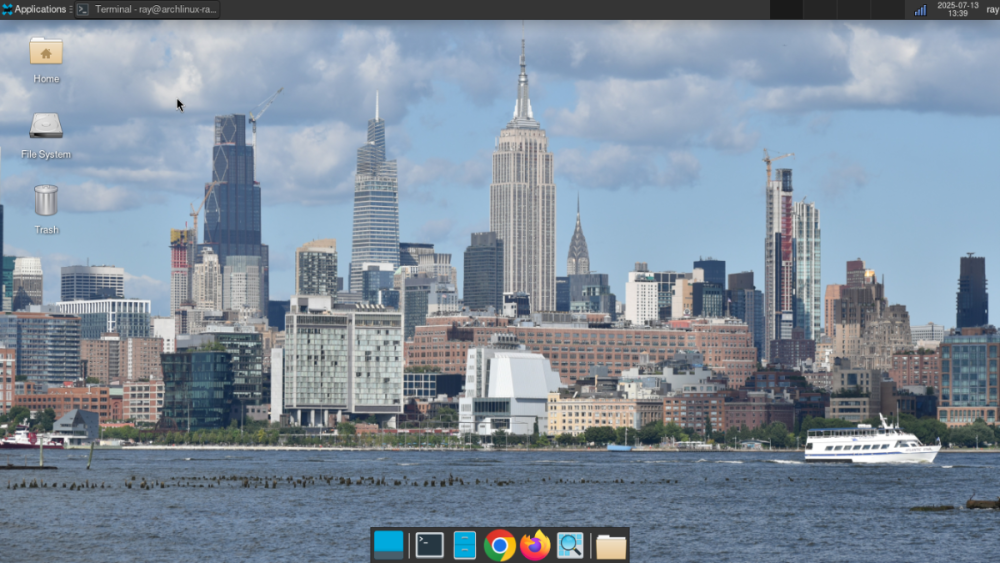All Activity
- Today
-
I like Endeavour a lot. Their Xfce desktop is far more attractive than I could generate on my own, and they have most of the tools I would want pre-installed - plus those nifty graphical updates. They do tend to be moving away from Xfce to Plasma but Xfce continues to be available, along with many other desktops. However, the archinstall script has brought Arch Linux very close in terms of user friendliness and makes it harder for me to use a derivative distro - even a virtual Arch clone.
-
this is why a "community of support" is one of my criteria for distro selection. I've seen some REALLY nice 1-developer distros....that eventually faded into oblivion. OTOH, a similar but related concern happens with corporate-sponsored distros. Those distros are likely to continue being developed, but could be snatched away for various reasons relating to profit motivations. I'm looking at Canonical and whomever is the parent company of SUSE now, and nearly everything in the RHEL family. If the parent company decides to change policies, or user terms, it's unilateral. Unless you have the infrastructure in place to fork, host, and develop....you're better off looking for a new distro. JMO... The happy medium, for me, is in between.....a respectable sized developer oligarchy behind the distro, but NOT corporate backed; and a friendly, welcoming, helpful community to help troubleshoot any issues and provide tutorials for new users. Distros like Debian, Mint, Manjaro and Arch come to mind. One could maybe question or argue how welcoming and helpful the Manjaro and Arch communities are (RTFM?!), but there is no question the Arch WIKI is the gold standard....I've consulted the Arch WIKI as a Debian user to successfully solve issues! With all that said, I consider Endeavour to be a "visually massaged and aesthetic Arch"; in the same manner that I consider Spiral to be Debian. If you pull packages from the repos of the "main distro" and simply add visual polish and/or non-free firmware (Spiral), I think the derivate is actually the main distro. JMO....but that is why I was willing to break my own rule of criteria regarding user-base when I selected Spiral as the base to make my custom Debian distro, as Spiral was much closer to my personal preferences than mother Debian was. While Spiral had a much smaller community, and not many users, I did verify that it 100% pulled from Debian repos. The biggest thing Spiral brought to the table was inclusion of the non-free firmware repo that was included as a default. Debian allows for that now, as per user preference, so I fully expect Spiral to die on the vine. But I'll be no worse off, because it draws 100% from Debian repos. No harm, no foul. Endeavour is nearly identical in that respect. 1 additional repo for Endeavour themes and aesthetics. If Endeavour folds, just comment out that repo to eliminate it and Endeavour will still be 100% Arch. Endeavour just presents a more advanced aesthetical start point than Arch; it's a shortcut. But I suspect most Arch users think like you did Ray, and actually prefer to customize Arch exactly how they want it; as opposed to how Endeavour thinks you might like? (Endeavour is very close to my tastes, so I like their shortcut, LOL!)
-
When I originally installed EndeavourOS it had a default Xfce desktop - which suited me fine. Now the ISO is set up for Plasma which I don't want to run. You can still get Xfce of course but you have to netinstall - meaning you need online access. Might as well run archinstall and get what you want. The very nice looking desktop remains with Endeavour and some nifty graphical tools but I can get by without them. I know for sure Arch will be around as long as I want to use it.
-
Agreed. Since Endeavor uses vanilla Arch repos and only really provides themes and icons in their repos, I don't see it going away. Just for testing purposes, I actually changed an Endeavor install into an Arch install a couple of years ago.
-
What Is Bazzite? Hands-On With the SteamOS Alternative
raymac46 replied to securitybreach's topic in Bruno's All Things Linux
Well maybe if you had a home theater system and you wanted to game in Linux it'd be okay. It looks pretty inflexible for the average Linux user though. Better to roll your own or install something like Garuda Linux.- 1 reply
-
- 1
-

-
I have installed EndeavourOS on another laptop but having used archinstall I don't really see the need to do so. For a first time user it's best to do things manually the Arch way and learn about Linux under the hood. I've done that enough so the archinstall speeds things up and you still control the process. EndeavourOS has a real pretty interface but I worry about long term development - will things end up like Antergos?
-
securitybreach started following A New Arch Linux Install and What Is Bazzite? Hands-On With the SteamOS Alternative
-

What Is Bazzite? Hands-On With the SteamOS Alternative
securitybreach posted a topic in Bruno's All Things Linux
https://www.howtogeek.com/what-is-bazzite-linux/ -
Nice Ray
- Yesterday
-
As many of you know, I have been nursing and updating an Arch Linux installation on an ancient Toshiba NB305 netbook for the last 8 years or so. This came to an end yesterday when the netbook battery died. I wanted to continue on with vanilla Arch, so I selected a new junker candidate - an HP Broadwell laptop from 2016 with a 1 TB SSD, Intel graphics, 8 GB RAM. This one had been running Linux Mint Xfce but I didn't need it for visitors usage. I decided to install Arch in its place. Got the iso and imaged it onto a USB stick without a problem. I booted the iso but when I tried iwctl to get online there was no wifi interface. I expected this because the HP had one of those balky Broadcom chipsets. I plugged in a USB wifi dongle, and although I now had a wlan0 interface I still could not find any networks. I spent some time researching the problem and after rfkill unblock commands and powering the interface up and down, eventually I found my LAN and connected. Then I ran the archinstall script and this is a beautiful thing. After going through all the configuration steps and selecting an Xfce desktop, I let it run and everything worked out great. After a reboot I was in a basic Xfce desktop. I suppose I could have done it manually but the script makes things so much easier, and you don't miss anything. Still no native wifi so I installed the broadcom-wl driver and I have native wifi now - no dongle needed. After that I installed yay just in case I need anything from the AUR. I also added the Whisker Menu to pretty things up. The HP is far more powerful and modern so hopefully I'll be set for a few more years of Arch.
-
Show Us Your GNU/Linux Desktop
raymac46 replied to V.T. Eric Layton's topic in Bruno's All Things Linux
-
Well, I've removed the SSD and I'll recycle the old Toshiba. But I'm back in business. I have another laptop which runs Intel Broadwell. I had Mint Xfce installed but I prefer Arch. So I've used the archinstall script to do the installation. Very fast and easy. I have some tweaking to do but it looks pretty good so far. For simplicity I'm sticking with Xfce as I have tons of RAM compared to the netbook. I can use Firefox and don't have to mess with lightweight and glitchy browsers. [ray@archlinux-ray ~]$ inxi -Fxz System: Kernel: 6.15.6-arch1-1 arch: x86_64 bits: 64 compiler: gcc v: 15.1.1 Desktop: Xfce v: 4.20.1 Distro: Arch Linux Machine: Type: Laptop System: Hewlett-Packard product: HP Pavilion Notebook v: Type1ProductConfigId serial: <superuser required> Mobo: Hewlett-Packard model: 8092 v: 89.33 serial: <superuser required> UEFI: Insyde v: F.82 date: 08/18/2016 Battery: ID-1: BAT0 charge: 14.2 Wh (61.2%) condition: 23.2/23.2 Wh (100.0%) volts: 15.1 min: 14.8 model: Hewlett-Packard Primary status: discharging CPU: Info: dual core model: Intel Core i5-5200U bits: 64 type: MT MCP arch: Broadwell rev: 4 cache: L1: 128 KiB L2: 512 KiB L3: 3 MiB Speed (MHz): avg: 898 min/max: 500/2700 cores: 1: 898 2: 898 3: 898 4: 898 bogomips: 17558 Flags: avx avx2 ht lm nx pae sse sse2 sse3 sse4_1 sse4_2 ssse3 Graphics: Device-1: Intel HD Graphics 5500 vendor: Hewlett-Packard driver: i915 v: kernel arch: Gen-8 bus-ID: 00:02.0 Device-2: Chicony HP Truevision HD driver: uvcvideo type: USB bus-ID: 1-3:3 Display: x11 server: X.org v: 1.21.1.18 driver: X: loaded: modesetting dri: iris gpu: i915 resolution: <missing: xdpyinfo/xrandr> resolution: 1366x768 API: EGL v: 1.5 drivers: iris,swrast platforms: active: gbm,x11,surfaceless,device inactive: wayland API: OpenGL v: 4.6 compat-v: 4.5 vendor: intel mesa v: 25.1.5-arch1.1 glx-v: 1.4 direct-render: yes renderer: Mesa Intel HD Graphics 5500 (BDW GT2) API: Vulkan v: 1.4.313 drivers: intel surfaces: N/A devices: 1 Info: Tools: api: eglinfo, glxinfo, vulkaninfo de: xfce4-display-settings x11: xprop Audio: Device-1: Intel Broadwell-U Audio vendor: Hewlett-Packard driver: snd_hda_intel v: kernel bus-ID: 00:03.0 Device-2: Intel Wildcat Point-LP High Definition Audio vendor: Hewlett-Packard driver: snd_hda_intel v: kernel bus-ID: 00:1b.0 API: ALSA v: k6.15.6-arch1-1 status: kernel-api Server-1: PipeWire v: 1.4.6 status: active Network: Device-1: Broadcom BCM43142 802.11b/g/n vendor: Hewlett-Packard driver: wl v: kernel bus-ID: 08:00.0 IF: wlan0 state: up mac: <filter> Device-2: Realtek RTL810xE PCI Express Fast Ethernet vendor: Hewlett-Packard driver: r8169 v: kernel port: 3000 bus-ID: 09:00.0 IF: eno1 state: down mac: <filter> Bluetooth: Device-1: Broadcom BCM43142A0 Bluetooth 4.0 driver: btusb v: 0.8 type: USB bus-ID: 1-7:4 Report: rfkill ID: hci0 rfk-id: 1 state: down bt-service: not found rfk-block: hardware: no software: no address: see --recommends Drives: Local Storage: total: 894.25 GiB used: 7.42 GiB (0.8%) ID-1: /dev/sda vendor: Patriot model: Burst Elite 960GB size: 894.25 GiB Partition: ID-1: / size: 878.13 GiB used: 7.25 GiB (0.8%) fs: ext4 dev: /dev/sda2 ID-2: /boot size: 1022 MiB used: 172.5 MiB (16.9%) fs: vfat dev: /dev/sda1 Swap: Alert: No swap data was found. Sensors: System Temperatures: cpu: 41.0 C mobo: N/A Fan Speeds (rpm): N/A Info: Memory: total: 8 GiB available: 7.67 GiB used: 661.2 MiB (8.4%) Processes: 173 Uptime: 0m Init: systemd Packages: 608 Compilers: gcc: 15.1.1 Shell: Bash v: 5.3.0 inxi: 3.3.38 [ray@archlinux-ray ~]$
-
Well folks I think the end is here for this old netbook. And it's a hardware failure - namely the battery has stopped charging. Attempts to reset the battery charging have failed. I have to pull out the SSD and then it'll be off to Staples for recycling. I do think that experiments with this netbook have proven the point that Arch can be installed once and run for a long time, which was my original objective.
-

Post the funniest thing you saw on the Internets today
securitybreach replied to amenditman's topic in The Restaurant at the Edge of the Universe
- Last week
-

Post the funniest thing you saw on the Internets today
securitybreach replied to amenditman's topic in The Restaurant at the Edge of the Universe
-

Post the funniest thing you saw on the Internets today
securitybreach replied to amenditman's topic in The Restaurant at the Edge of the Universe
-

Show Us Your GNU/Linux Desktop
abarbarian replied to V.T. Eric Layton's topic in Bruno's All Things Linux
-
.thumb.jpg.7c3caaf218a75d76e16db7a5bddfb463.jpg)
Post the funniest thing you saw on the Internets today
Corrine replied to amenditman's topic in The Restaurant at the Edge of the Universe
-
Malwarebytes v5.3.4.202 component package 136.0.5312 released. From MBAM 5.0: Features and improvements Added a quick way for users to submit feedback without needing a forum account Other minor usability improvements across the interface Issues fixed Fixed Tray Menu positioning issues on some multi-monitor setups
-
For now the old netbook seems to be OK with Firefox and Midori - at least as far as posting to this forum. I suppose I'll keep it stashed away until it won't work at all.
-
And that's how you learn...
-
Yeah a FAFO Arch user probably makes his own mistakes more often than the packages are unstable. I have been known to dabble in the AUR.
-
You just get the latest version of an app when it hits stable on Arch
-
I agree with you but actually Arch Linux uses the latest stable versions of applications unless you install a newer one from the aur.
-
In my view there are two types of Linux users - Git 'Er Dun (folks with serious mission critical uses) and F*** Around and Find Out (folks who use Linux as a hobby or for fun.) I have the utmost respect for GED folks using rolling release distros but I certainly understand the logic of stable point releases here. Personally I am a FAFO user so I run Arch or Debian Testing for personal use, and GED Linux Mint for visitors and family members. My worst example of FAFO is running Debian Testing with GNOME Extensions. It's a recipe for disaster, but you can learn a lot. I've found that Arch is more stable than the toxic cocktail of GNOME and Debian Testing.
-
Maybe I've discovered Ray's Law. Old Hardware and new Software will work together until they don't. It isn't a gradual disintegration either. Things go swimmingly for years, then the software requires a non-existent feature in the hardware and **CRASH!!!!** just like Wile E. Coyote running off a cliff.




